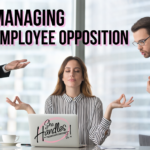Saying you have a positive company culture is one thing, but defining it is entirely different. Every office setting or work environment has a specific corporate culture. The narrative here is setting and defining the culture versus allowing it to be created on its own.
Understanding the difference is HUGE in any business. You want to define your culture and not let your culture define you.
Have you previously or are you currently working in an environment that is guilty of having a culture defined on its own? There are many of these cultures out there, ones that can be described as “uptight,” “boys clubs,” “workhorses,” or “robots.”
Those are examples of businesses or companies that lack the initiative to decide what type of culture they want. There was no plan put into action, and these companies you’re all too familiar with do not achieve a culture but, more importantly, obtain it.
How Do You Define the Culture of the Workplace?
How do you go about defining the type of workplace culture that you want your company to have? There are a few easy steps you should take first. These will lead you down the path to establishing this critical piece for any growing or established business. That process starts with a few questions.
- What is the current culture like?
- What are the specific qualifications your employees must have to work at your company?
- What do your current team members value the most out of the day to day experience at the workplace?
It’s imperative to understand what your current culture is. Do you have a highly professional culture that requires employees not only to talk the talk but walk the walk as well? Doctors’ offices, law firms, and accounting firms may have an environment that requires the utmost level of professionalism in appearance and duty.
How Corporate Culture Speaks
That type of business has to make sure that they maintain that, and their culture has to speak to those types of potential employees. Ensure that current employees never waiver from a necessity of a particular field. In this type of workplace, you may want a culture that allows employees to entertain or wow potential customers versus a fun environment.
Those fields might also command a vast education with Master’s Degrees or specific MBA requirements. With a business that attracts talent like that, you can focus more on a candidate’s knowledge and less on their outward appearance and education. Other areas, such as Digital Agencies and Marketing Firms, are slightly more laid back and creative. You may not require immense schooling, but insightful creativity and the ability to think outside the box.
Whether you are a new or existing business, you have at least a handful of employees that you value greatly and hope never to keep long term. These employees are your lifeline to creating and maintaining that desired culture and employee happiness. You need to speak with them at length and listen to what they have to say. Ask them a few questions to get a true perspective on employee experience:
- What do they like most about the office setting now?
- What would they love to see added?
- What is the one thing they would change if they could?
You might be surprised at what they say if they don’t mention something you feel is your workplace culture’s selling or focal point.
What Leads to Business Success?
At 1SEO.com Digital Agency, we uncovered that our employees valued having lunch provided in the office over having a pool table. Our employees enjoy having an open floor setting and a ton of snacks to break up the monotony of the day.
Having fully paid benefits is valued more than having additional days off during the year. People feel that these features are what create a great workplace.
Without taking that initial audit of what our employees felt, we would just have continued building onto our “Office Playground.” Every office dynamic is different, and no two companies’ cores are the same, no matter how closely related or comparable they may be.
Forming Your Culture Plan
Now that you have taken the time to uncover what your valued employees want and don’t want in the office environment, you can build a culture that maintains the happiness and well-being of both your business and your employees; thus improving company culture.
Remember, “Happy employees are productive employees.” You have to make sure you clearly define the culture for both current and prospective employees, and your leadership team. Your culture plan should include some of, if not all of the following to create a culture and achieve maximum employee engagement:
- Organizational Culture – ex: Cubicles, Office, Open Floor Plan
- Benefits – ex: Medical/Dental Plans, Retirement
- PTO – ex: Sick Time, Vacation Time, Paid Holidays
- Food Benefits – ex: Snacks, Paid Lunches, Cafeteria
- Culture-Specific Add-Ons – ex: Pool Tables, Team Building, Recognition Plans
- Customer Experience – How do you want employees treating/interacting with clients and customers?
I know that is a lot to consider about your culture, but you only have to do this once if done correctly.
Workplace culture isn’t about one puzzle piece; it’s about all the tiny components that make up who you are as an organization. If it is not clearly defined, you cannot maintain it, and you most certainly won’t be able to relay it to potential employees to be successful.
A very significant portion of your interview process should be dedicated to discussing the culture of your business. Candidates need to know what they can be expected to uphold upon entering into a professional contract with you.
Workplace Culture Done Right Affects Everyone
Not every workplace culture fits every individual. Some candidates are not comfortable working in an open floor plan. Others do not like the isolation of a single office setting.
Specific individuals genuinely value taking a Ping Pong break or going to happy hour at lunch, while another set of individuals prefers the solitude of their cubicles. Some businesses need the mentality of “shaking hands and kissing babies” when customers walk in the door. Others don’t require their employees to interact at all.
There is no right or wrong when it comes to workplace culture; there is simply the culture that fits your organization and the culture that doesn’t. Having the right workplace culture reduces your employee turnover by allowing them to be happy and invested because they genuinely believe in what your company stands for.
Let’s face it, we all want to work for or with someone they can truly stand behind. When done right, Workplace Culture affects everyone. When done right, your culture will define who you are, who you want around you, and who you want to do work for.
Last modified: March 18, 2022











Hey there would you mind sharing which blog platform you’re using? I’m going to start my own blog soon but I’m having a tough time deciding between BlogEngine/Wordpress/B2evolution and Drupal. The reason I ask is because your design seems different then most blogs and I’m looking for something unique. P.S My apologies for getting off-topic but I had to ask!
This is straight WordPress. I used elementor to build it
I have not checked in here for a while as I thought it was getting boring, but the last few posts are great quality so I guess I will add you back to my daily bloglist. You deserve it my friend 🙂
Wow, incredible blog format! How long have you been running a blog for? you make running a blog glance easy. The total glance of your website is excellent, as well as the content!
Wohh just what I was searching for, appreciate it for putting up.
My spouse and i ended up being absolutely relieved Edward could round up his research from the ideas he came across through your blog. It is now and again perplexing to just choose to be giving away methods which often the rest have been trying to sell. And now we already know we’ve got the writer to give thanks to for that. The explanations you’ve made, the easy blog navigation, the friendships your site give support to promote – it is most extraordinary, and it is facilitating our son in addition to the family recognize that this subject matter is enjoyable, which is unbelievably essential. Thanks for all!
I’m usually to running a blog and i really appreciate your content. The article has really peaks my interest. I am going to bookmark your website and maintain checking for brand spanking new information.
I do not even know how I ended up here, but I thought this post was great. I do not know who you are but certainly you are going to a famous blogger if you aren’t already 😉 Cheers!
Youre so cool! I dont suppose Ive learn something like this before. So good to find any person with some unique thoughts on this subject. realy thank you for starting this up. this website is something that is needed on the net, somebody with a little bit originality. helpful job for bringing one thing new to the web!